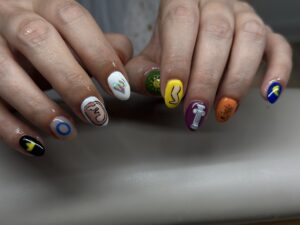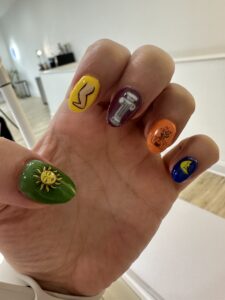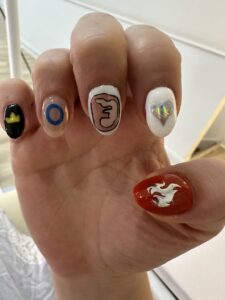by Anna Coufal
“The ten sefirot are the basis- the number of the ten fingers, five opposite five, and the covenant of unity is exactly in the middle by the word of the tongue and mouth and the circumcision of the flesh.”
So states Sefer Yetzirah, an enigmatic, mystical, and perhaps even magical medieval Jewish text. This foundational text has intrigued and baffled countless generations of kabbalists who sought to delve deeper into what the ten sefirot are and how they differentiate and ultimately unite to compose and influence the God we know and the universe we inhabit. Despite the enigmatic nature of the kabbalistic texts, the sefirot remain hugely popular today in the Jewish imagination. In this period between Pesach and Shavuot, many of us have been contemplating the seven lower sefirot as we count the Omer.

As someone who doesn’t always wear a head covering or tzit-tzit, I’ve been experimenting with nail art as a way to outwardly express and inwardly remember my Judaism as well as to feel in sync with Jewish time. In my opinion, nail art is one of the most interesting art forms of the 21st century- it is truly remarkable what some nail techs are capable of creating. For Pesach, I got French tips that had waves instead of the traditional white line to commemorate crossing the Sea of Reeds. For this period leading up to Shavuot, I decided to go with a sefirot theme. Based on traditional colors and symbols associated with each sefirah, I designed each nail with the help of my wonderful nail tech, Chelsea. Some images we found as stickers, and Chelsea painted the odd ones we couldn’t find. Special thanks to Chelsea and O’Studio in Philly! And special thanks to my professor, Joel Hecker, for teaching me about kabbalah and inspiring this project.

- Keter: Symbolized by the crown and the color black, the first sefirah is keter. Because the ten emanations appear to be finite, the kabbalists envisioned an infinite divinity, ein sof, that connects with this first sefirah, desiring or willing to come into being. This sefirah is also known as ratzon, Will of Wills, ayin, keter elyon or rum ma’alah. Here it is illustrated as a crown.
- Chochmah: The second sefirah is chochmah, which means wisdom. Chochmah is the primordial point, the origin of existence known as “hidden thought” or “seed of thought.” This type of thought is undifferentiated. It also corresponds to father. Chochmah and sometimes its complement, binah, have been linked with the brain. Here it is symbolized by a circle.
- Binah: Binah is the third sefirah, and it means understanding. Unlike Chochmah, which is active and full of potential energy, Binah is more of a receptive energy that complements its counterpart. It can also refer to a palace, discernment, or teshuvah. Corresponding to the heart, the womb and to mother, it seeks union with chochmah in order to produce the seven “lower” sefirot. Check out that womb! (Thank you Chelsea!)
- Chesed: As mentioned before, all of the following seven sefirot are said to have emanated from the womb of Binah as impregnated by Chochmah. Chesed, our fourth sefirah, means love. Also known as Gedulah, or Greatness, chesed is associated with the right arm and Abraham as well as the color white and water. Its complement is gevurah, the two must always work together. Here chesed is symbolized by a heart.
- Gevurah: Gevurah, our fifth sefirah, is also known as “din,” or judgment, and it refers to strength or power. Without chesed, gevurah can be an overpowering and destructive force, but in moderation it serves to create firm boundaries. It is associated with the left arm and Isaac as well as the color red and fire. It is represented here by a flame.
- Tiferet: The synthesis of Chesed and Gevurah is our sixth sefirah, Tiferet, which means beauty, splendor, or balance. Sometimes it is depicted as being in love/having sex with the last sefirah, malkhut. Typically associated with the sun, the torso, and the spine, it is also connected with the colors green, yellow and purple. The rest of the sefirot emanate from tiferet. Here it is symbolized by the sun.
- Netzach: Netzach, which means endurance or victory, is a pair with Hod. Together, they symbolize the pillars of the temple, kidneys, and prophecy. Netzach is specifically associated with Moses and the right leg. Here it is symbolized by a leg.
- Hod: As mentioned previously, Hod is a pair with Netzach. Together, they symbolize the pillars of the temple, kidneys, and prophecy. Hod means majesty or humility, and it is associated with Aaron and the left leg. It is illustrated here by a pillar.
- Yesod: The penultimate sefirah means foundation or connection. It is associated with covenant and with the tree of life, as well as with phallus, breasts, peace, and Joseph. It connects the rest of the sefirot with the final sefirah. Here it is represented by a “tree” (or a woman with flowers growing instead of a head- same thing).
- Malkhut: The final sefirah means kingdom. It is also known as Shekhinah, which is the feminine presence of G-d that dwells on earth. The symbolism of malkhut is rich- it is commonly associated with land, moon, queen, bride, princess, apple orchard, mouth, rainbow or the color blue. Sometimes it is depicted as being in love/having sex with the sixth sefirah, tiferet. It is represented here by the moon.

Anna Coufal is a rabbinical student at RRC.






